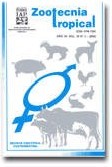
|
Zootecnia Tropical
Instituto Nacional de Investigaciones Agrícolas Venezuela
ISSN: 0798-7269
Vol. 20, No. 4, 2002, pp. 473-482
|
 Bioline Code: zt02030
Bioline Code: zt02030
Full paper language: Spanish
Document type: Research Article
Document available free of charge
|
|
|
Zootecnia Tropical, Vol. 20, No. 4, 2002, pp. 473-482
| en |
Evaluation of different hormonal treatments for the synchronization of the estro in Serrana Creole goats during the summer
Rodrigo Ruiz, Jorge L. Fernández; Adolfo C. de la Vega. y Alicia E. Rabasa
Abstract
The aim of this work was to evaluate the efficiency of two hormonal treatments in the synchronization of estrus in Criollas Serranas goats during the summer season. It was carried out using 79 female goats, with a completely randomized design, comparing the following treatments: T1, Prostaglandin F2a (n=27): two doses of 325 mg/goat (sc) of cloprostenol, separated 12 days one from the other; T2, Progestagen (n=26): intra vaginal sponge with 60 mg of acetate medroxiprogesterone, during 12 days, with out any associated luteolytical agent and T3, Control group (n=26): received no hormonal treatment. The percentage of synchronized estrus, average time until the manifestation of the estrus, and the fertility of these goats, measured through the percentage of kidding, were evaluated. The estrus were detected during 10 days post treatment. Data were analyzed by χ2 test and ANOVA. There were found highly significant differences between the percentage of the detected estrus in the hormonal treatments and the control group ( T1, 66.7%; T2, 65.4% y T3, 26.9%). No significant differences were found for the average time in the manifestation estrus in the hormonal treatments (T1, 90.7 ± 11.6 h.; T2, 77.6 ± 7.8 h.) and fertility was not altered by the hormonal action (T1, 50%, T2, 70.6% y T3, 71.4%). It was concluded that the hormonal treatments used were efficient to synchronize the estrus without altering the fertility of the goats.
|
| |
| es |
Evaluación de diferentes tratamientos hormonales para la sincronización del estro en cabras criollas serranas durante el verano
Rodrigo Ruiz, Jorge L. Fernández; Adolfo C. de la Vega. y Alicia E. Rabasa
Resumen
El objetivo de este trabajo fue evaluar la eficiencia de dos tratamientos hormonales en la sincronización de celos en cabras Criollas Serranas durante el verano. El mismo se realizó con 79 hembras, con un diseño completamente aleatorizado, con los siguientes tratamientos: T1, Prostaglandina F2μ (n = 27): dos aplicaciones de 325 mg/cabra (sc) de cloprostenol, espaciadas 12 días una de otra; T2, Progestágeno (n =26): esponja intravaginal con 60 mg de acetato de medroxiprogesterona, durante 12 días, sin agente luteolítico asociado; y T3, Testigo (n=26): sin tratamiento hormonal. Se evaluó el porcentaje de celos sincronizados, el tiempo promedio transcurrido hasta la manifestación del estro y la fertilidad de los mismos medida como porcentaje de parición. La detección de los celos se realizó durante 10 días. Para el análisis estadístico de los datos se utilizó la prueba de Chi cuadrado (χ2) y un ANOVA. Se encontraron diferencias altamente significativas en el % de celos detectados entre los tratamientos hormonales y el testigo (T1, 66,7%; T2, 65,4% y T3, 26,9%). No hubo diferencias significativas para el tiempo promedio a la manifestación del estro en los tratamientos hormonales (T1, 90,7 ± 11,6 h.; T2, 77.6 ± 7,8 h.), y la fertilidad no fue alterada por la acción hormonal (T1, 50,0%, T2, 70,6% y T3, 71,4%). Se concluye que los tratamientos utilizados fueron eficaces para la sincronización de los celos, sin afectar la fertilidad de los mismos.
Palabras-clave
caprinos, celo, sincronización, fertilidad, hormonas
|
| |
© Copyright 2002 - Zootecnia Tropical. Free full-text also available online at http://www.ceniap.gov.ve/bdigital/ztzoo/ztindice.htm
Alternative site location: http://www.sian.inia.gob.ve/repositorio/revistas_ci/ZootecniaTropical/ztindice.htm
|
|
